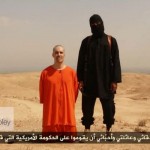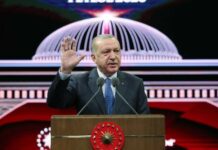 By Ruthie Blum
By Ruthie Blum
The video of the beheading of American journalist James Foley went viral last week, despite Twitter and YouTube efforts to remove it from their sites for its graphic content.
This is understandable, as there is an element of voyeurism involved in watching the gory clip. And its mass circulation has the unintentional effect of cheapening the horror of Foley’s death in an almost pornographic way.
However, it is precisely the chilling depiction of the slaughter that provides the world with a glimpse into the nature of the Islamic State group (ISIS), the Sunni terrorist organization that is trying to take over Syria and Iraq, before turning the entire region (and then the world) into an Islamic caliphate.
Not that the group has been hiding its blood lust. On the contrary, it is proud of its brutality and pedophilia. And tales of its raping, maiming and killing of Christians are being told, albeit with far less gusto than the media reserves for Israeli air strikes in Gaza.
Nor was it unknown in Washington that Foley and other Americans were being held by ISIS.
But it wasn’t until President Barack Obama watched the footage of Foley’s murder, in the video titled “Message to America,” that the ostensible leader of the Free World was forced to face what the West is up against. And though his response was to say that ISIS ”speaks for no religion,” even he could not escape the horrors going on in the Middle East – and in this case cultivated in Britain – perpetrated by Islamists.
Indeed, it is one thing to spend years theorizing, strategizing and looking the other way when mass murder is taking place; it is quite another to see an individual U.S. citizen being executed on camera.
Israeli Prime Minister Benjamin Netanyahu took the opportunity of the shock value of the video to tell the world, particularly the Obama administration, that “Hamas is ISIS. ISIS is Hamas. They’re the enemies of peace, they’re the enemies of Israel, they’re the enemies of all civilized countries.”
Netanyahu’s restating of the obvious about terrorism did no good, however. Ten minutes after extending public condolences to Foley’s grief-stricken parents, Obama was off to the golf course, and State Department deputy spokeswoman Marie Harf was telling the press that Netanyahu’s comparison was not accurate. “I think by definition they are two different groups,” she said.
Harf had to say that. Otherwise, how could her bosses continue to “caution” Israel about the use of excessive force against Hamas targets in Gaza?
Which brings us to one of Israel’s main handicaps in the battle it keeps losing in the international arena: a lack of willingness, based on moral concerns, to employ the PR methods of its enemies. Israel has truth on its side. But lies sell better and spread faster than facts.
Nowhere is this more evident than inside a media outlet that strives to uphold a professional level of journalistic standards and ethics. It is something I experienced first hand as a member of the editorial staff of The Jerusalem Post during the Second Intifada. This was the suicide-bombing war launched by Nobel Peace Prize laureate Yasser Arafat in answer to the Oslo Accords, which he repeatedly breached.
That guerrilla war, which began in 2000 and culminated in Israel’s unilateral withdrawal from Gaza, was characterized by its barbarism. Every day Palestinian terrorists blew themselves up on buses, in restaurants and at malls. The ensuing carnage was horrifying beyond belief.
Whenever interviewed at the scene of one of these crimes against humanity, police and paramedics always said the same thing: that they would never get used to seeing and dealing with this kind of abomination. Each such incident was so bloody and full of severed body parts that even seasoned security and ambulance personnel were deeply traumatized.
At every morning meeting, held to discuss the stories that we would cover in the paper for the following day, we would end up debating the issue of the photos accompanying the inevitable terrorist attack or, as was often the case, multiple attacks.
Publishing gruesome pictures was deemed by a majority of the editors to be out of the question for a number of reasons, chief among them the dignity of the dead and the privacy of their families. After all, who can bear seeing a child’s bloody backpack on the ground – with its owner’s name in plain sight – next to an arm or a leg of someone else?
On one occasion, the blown-off head of a suicide bomber flew into a schoolyard in Jerusalem, and we noted the invisible injuries sustained by those onlookers fortunate enough to have emerged physically unscathed from the bombing. But without an illustration of what a severed head rolling into a schoolyard actually looks like, it is hard to grasp. Still, the decision stood: the photo would not appear in our pages.
The Palestinian press had a different approach. Any retaliatory action on Israel’s part was met with a media blitz of blood and gore for the world to see. Then, as today, many of their photos were staged, stolen from previous wars in other countries and touched up for both local and foreign consumption.
Then, as today, it has the desired effect. Israel looks like a vicious Goliath trampling a helpless David. After that, the rest is catch-up commentary that nobody listens to or believes.
A perfect example was the alleged and subsequently debunked Jenin “massacre.” As part of Operation Defensive Shield in 2002, the Israel Defense Forces entered the Jenin refugee camp in Judea and Samaria (the West Bank) to snuff out and extinguish terrorist strongholds from where many of the suicide bombings were planned and carried out.
While we editors were busy keeping photos of dismembered Israeli men, women and children away from the already shaky public, the Palestinian Authority media were having a field day with their own footage. By the time the U.N. determined that what happened in Jenin was not a massacre, it was too late. The damage had been done to Israel, and all that remained was to try and shake off the residue.
A picture is not merely worth a thousand words. When monstrous enough, it renders one speechless. Just ask anyone who viewed the Foley decapitation.
Perhaps the time has come to show our own photos for a change.
{Matzav.com Newscenter}











No no no we should never stoop to that level. Besides this has nothing to do with media hype. It’s anti semetic in its most blatant form & nothing will ever change that, ad be’as goel tzedek.
“I think by definition they are two ?different groups”
They ARE different, they have different leadership, they don’t appear to talk to each other, and one only targets Israel. They do share a similar ideology but that does not make them the same. And falsely claiming that they ARE the same is one reason why Israel has a PR problem.